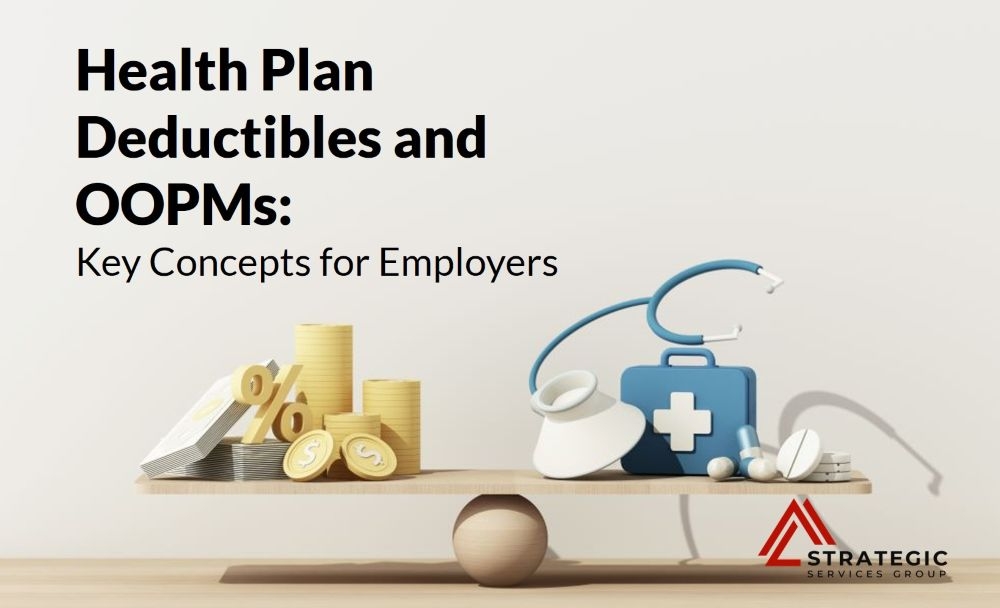Health Plan Deductibles and OOPMs – Key Concepts for Employers

Deductibles and out-of-pocket maximums (OOPMs) are important cost-sharing parameters for health plans. A deductible is the amount an individual must pay in covered health care expenses each year before the health plan starts paying. An OOPM is the overall limit on an individual’s annual out-of-pocket spending on covered health care expenses. Once an individual reaches their OOPM, their health plan pays 100% of covered expenses for the rest of the year. Generally, health plans with higher cost-sharing limits have lower monthly premiums than health plans with lower deductibles and OOPMs.
While employers have a considerable amount of flexibility when it comes to setting deductibles and OOPMs each year, there are some important restrictions. For example, high-deductible health plans (HDHPs) that are compatible with health savings account (HSA) contributions must comply with IRS limits for minimum deductibles and OOPMs. Also, all health plans must comply with the Affordable Care Act’s (ACA) OOPM on essential health benefits (EHBs). Because these limits are adjusted for inflation each year, employers should carefully review their plan design before the start of each plan year for compliance.
Embedded Limits
- Health plans often embed (or include) an individual deductible and individual OOPM in family coverage
- HDHPs cannot embed an individual deductible in family coverage that is lower than the minimum HDHP family deductible.
- Health plans must embed an individual OOPM in family coverage if the family OOPM is greater than the ACA’s OOPM for self-only coverage.
Dollar Limits for 2025
The following limits apply to plan years beginning in 2025:
- HDHP minimum deductibles: $1,650 for self-only coverage and $3,300 for family coverage;
- HDHP OOPM: $8,300 for self-only coverage and $16,600 for family coverage; and
- ACA OOPM on EHB: $9,200 for self-only coverage and $18,400 for family coverage.
Deductibles
General Rules
A deductible is the fixed amount an individual must pay for covered health care expenses each year before their health plan begins to pay benefits. Deductibles can range from hundreds to thousands of dollars each year, depending on the health plan’s design. When an individual reaches the deductible amount, their health plan will start paying a portion of their covered health care expenses for the rest of the year. For example, if an individual is subject to a $1,000 deductible, they would be responsible for paying for their covered health care expenses until their out-of-pocket costs reach $1,000. After that, the health plan would begin paying covered health care costs, although individuals may still be responsible for copays, coinsurance and balance billing charges from out-of-network providers.
A health plan’s deductible resets at the beginning of each plan year and may change from year to year. An individual’s out-of-pocket costs for noncovered expenses do not count toward the deductible.
Many health plans have a deductible for in-network benefits and a separate, higher deductible for out-of-network benefits. Typically, out-of-pocket costs for covered health care provided by in-network providers count toward the network deductible, while out-of-pocket costs for covered health care provided by out-of-network providers count toward the out-of-network deductible. However, three categories of out-of-network medical services—emergency services, nonemergency services provided by an out-of-network provider during a visit at an in-network health care facility, and air ambulance services—are subject to special restrictions on surprise medical billing and must be counted toward in-network cost-sharing limits.
A health plan’s deductible may not apply to all covered health care expenses. For example, the ACA requires non-grandfathered health plans and health insurance issuers to cover certain preventive care services without imposing any cost sharing (i.e., deductibles, copays and coinsurance) when the services are provided by in-network providers. These preventive health services include, for example, many cancer screenings, blood pressure, diabetes and cholesterol tests, vaccinations against diseases, contraceptives, and counseling on topics such as quitting smoking and losing weight. Other types of covered health care expenses (e.g., prescription drugs) may be subject to a separate deductible, depending on the plan’s design. However, to comply with mental health parity laws, a health plan cannot have a separate deductible for mental health or substance use disorder benefits.
Federal law does not impose an overall minimum or maximum limit for health plan deductibles. However, to qualify as an HDHP that is compatible with HSA contributions, a health plan must satisfy an annual minimum deductible requirement. Also, a health plan’s overall cost-sharing limit (deductibles, copays and coinsurance) must comply with an OOPM under the ACA. A lower OOPM applies to HDHPs.
Continue Reading this SSG Compliance Advisor to learn more about:
- HDHPs: Minimum Deductibles
- Embedded Deductibles: HDHPs and OOPM
- OOPM: General Rules & Dollar Limits
- Embedded OOPMs
Links and Resources
- IRS Revenue Procedure 2024-25, providing the inflation-adjusted HSA/HDHP limits for 2025
- Final rule requiring health plans to apply the ACA’s OOPM for self-only coverage to every covered individual
- U.S. Department of Health and Human Services’ (HHS) guidance on the ACA’s OOPM for 2026 plan years

 Prev
Prev

